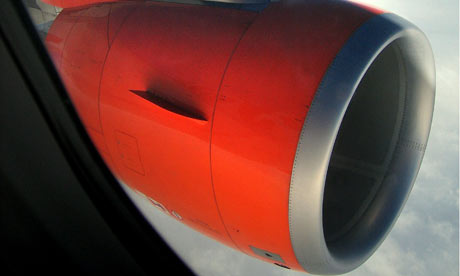EasyJet says its flights have a smaller carbon footprint than a Toyota Prius hybrid car. Let's do the maths…
- guardian.co.uk, Thursday 23 July 2009 08.00 BST

EasyJet claims its flights have smaller carbon footprints than a Toyota Prius. Photograph: Philippe Hays/Rex Features
You probably weren't watching BBC3 at 4am on Monday morning. Not if you had a job to go to in the morning, anyhow. So you probably missed a nice little programme called Britain's Embarrassing Emissions.
It door-stepped the budget airline easyJet about claims on the company's website that it is greener than a hybrid car. Or, more particularly, that its emissions were less than those of a Toyota Prius. It's greenwash, of course. As, I discovered, are several of its other environmental claims.
The crux of the matter is the company's website, which highlights a graph showing that its emissions "based on one person" are 95.7g/km, whereas those for a Prius are 104g/km. As the programme pointed out, this is not comparing like with like. EasyJet doesn't say so, but its "typical comparison" is very atypical. It assumes that the plane is full and its emissions are shared out among all the passengers, while the Prius is presumed to have only one occupant.
EasyJet may succeed in its aim of completely filling up every flight (though it is not true in my experience). But all British official stats on car emissions reckon on an average of 1.6 passengers in a car. Eastjet presumably didn't follow this convention, because it would show even a full easyJet flight emitting 47% more per passenger-kilometre than an averagely full Prius. And of course a full easyJet flight would emit close to for four times as much per passenger as a full Prius carrying four people.
In the programme, which I'm guessing was filmed recently, the hapless easyJet spokesman appeared to promise to try and get the website changed to reflect reality. Not so far, it hasn't. The greenwash persists. And if the claims are repeated in any of easyJet's advertising perhaps someone fancies contacting the Advertising Standards Authority...
But the environment pages of easyJet's site contain other slippery claims. They repeatedly proclaim that "aviation's carbon dioxide emissions... only account for 1.6% of global greenhouse gas emissions", citing as the source Lord Stern's famous review of the economics of climate change. But the company ignores the next sentence in Stern's text, which says that "the impact of aviation on climate change is greater than these figures suggest because of other gases released by aircraft... for example water vapour". These emissions roughly double the effect, says Stern. So make that 3.2%.
Oddly enough, easyJet's seems seems not to trust its headline claims. Its own report on corporate and social responsibility quotes a figure of 3.5% contained in a report from the Intergovernmental Panel on Climate Change in 1999.
In any event, both Stern and the IPCC report are out of date. Stern's data come from someone else's report in 2005, which in turn cites data for 2002. Since when global aircraft emissions have grown by about 40%. And IPCC scientists now quote a figure for aviation's contribution to global warming of almost 5%.
Whatever aviation's true contribution to global warming, it is not 1.6%.
What else does easyJet offer to reassure its growing number of passengers that it is green to fly? Naturally, since it doesn't fly to the US, the company flags up how flying to Europe is better. So it says in big letters: "Flying from London to Nice produces 10 times fewer CO2 emissions than flying London to Miami."
Leaving aside the ugly English, I am not sure this stands up. Since easyJet doesn't fly to Miami, we can't check the stat on its own carbon calculator. But a couple of others I went to, including Climate Care, show the difference at a bit over eight times.
The comparison is misleading in a more important way, however. If I need to get to Miami, I have little choice other than to fly. Whereas if i need to get to Nice, I can catch a train. It might take a bit longer, but it will save on carbon. Thanks to the nuclear power-running Eurostar and the French railways, my emissions would be, very roughly, one-tenth those of flying. With easyJet or anyone else.





